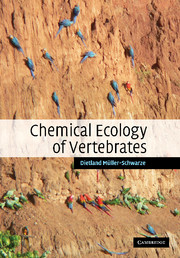Book contents
- Frontmatter
- Contents
- Preface
- Acknowledgements
- 1 The odorsphere: the environment for transmission of chemical signals
- 2 Properties of vertebrate semiochemicals
- 3 Odor production and release
- 4 Chemical cues in orientation and navigation
- 5 Chemoreception
- 6 Signaling pheromones I: discrimination and recognition
- 7 Signaling pheromones II: sex and alarm pheromones and evolutionary considerations
- 8 Intraspecific signals: priming pheromones
- 9 Development of intra- and interspecific chemical communication
- 10 Allomones I: chemical defense by animals
- 11 Allomones II: plant chemical defenses against herbivores
- 12 Kairomones and synomones
- 13 Practical applications of semiochemicals
- Glosssary
- References
- Index
3 - Odor production and release
Published online by Cambridge University Press: 23 November 2009
- Frontmatter
- Contents
- Preface
- Acknowledgements
- 1 The odorsphere: the environment for transmission of chemical signals
- 2 Properties of vertebrate semiochemicals
- 3 Odor production and release
- 4 Chemical cues in orientation and navigation
- 5 Chemoreception
- 6 Signaling pheromones I: discrimination and recognition
- 7 Signaling pheromones II: sex and alarm pheromones and evolutionary considerations
- 8 Intraspecific signals: priming pheromones
- 9 Development of intra- and interspecific chemical communication
- 10 Allomones I: chemical defense by animals
- 11 Allomones II: plant chemical defenses against herbivores
- 12 Kairomones and synomones
- 13 Practical applications of semiochemicals
- Glosssary
- References
- Index
Summary
The odour emitted must be of considerable importance to the male, inasmuch as large and complex glands, furnished with muscles for everting the sack, and for closing or opening the orifice, have in some cases been developed. The development of these organs is intelligible through sexual selection, if the most odoriferous males are the most successful in winning the females, and in leaving offspring to inherit their gradually-perfected glands and odours.
charles darwin:The Descent of Man, p. 530Among mammals, which mostly “think through their noses,” it is not surprising that olfactory marking of their territory plays a large role. The most diverse methods have been chosen, various scent glands evolved, and the most remarkable displays of depositing urine and feces developed; of these, the leg-lifting of the domestic dog is most familiar to everyone.
konrad lorenz:On Aggression (1963), p. 53 of original German version, translated by author.Chemosignals in vertebrates come from a great variety of sources. These sources include excretions, secretions, material recycled from other organisms, and even from the environment.
Signals in excretions
Metabolites in urine or feces provide the energetically least expensive, and evolutionarily probably the original, chemical signals in vertebrates. “Much of history of evolution has concerned the development by living things of responses to metabolites, sometimes their own and sometimes produced by others. Those organisms which developed ‘satisfactory’ responses succeeded, and those which did not, failed.” (Lucas, 1944). Interested parties, such as members of the opposite sex, can then “spy” and read pertinent information about sexual and dominance status, health and body condition, quality of diet, and more.
- Type
- Chapter
- Information
- Chemical Ecology of Vertebrates , pp. 36 - 59Publisher: Cambridge University PressPrint publication year: 2006



